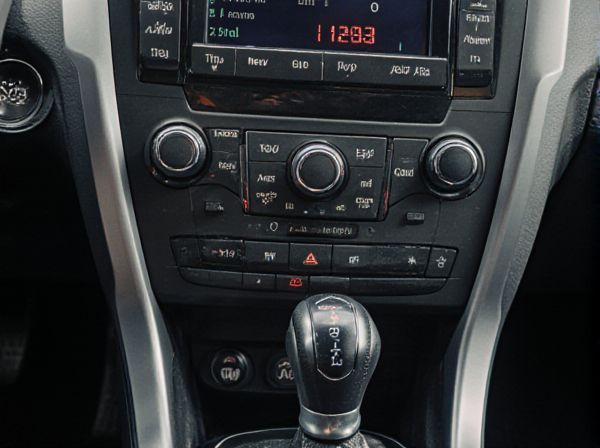
Photo illustration: Direct-shift vs Traditional automatic
Direct-shift transmissions (DCT) offer faster gear changes and improved fuel efficiency compared to traditional automatic transmissions, which use a torque converter and can experience slight power loss. Your driving experience with a DCT is typically sportier and more responsive, while traditional automatics provide smoother, more seamless shifts ideal for comfort. Maintenance and repair costs may be higher for DCTs due to their complex twin-clutch design.
Table of Comparison
| Feature | Direct-Shift Transmission (DCT) | Traditional Automatic Transmission |
|---|---|---|
| Shift Speed | Ultra-fast, seamless gear changes | Slower, less precise shifts |
| Efficiency | Higher fuel efficiency due to minimal power loss | Lower fuel efficiency with greater power loss |
| Complexity | Dual clutch system with electronic control | Hydraulic torque converter-based system |
| Driving Experience | Sporty, responsive, and smooth | Smoother at low speeds, less sporty feel |
| Maintenance | Higher cost, complex repairs | Lower cost, simpler repairs |
| Common Use | Performance cars, modern vehicles | Mass-market cars, older models |
Introduction to Transmission Technologies
Direct-shift transmissions (DCT) feature dual clutches enabling rapid gear changes with improved fuel efficiency compared to traditional automatic transmissions that rely on a torque converter. Traditional automatics offer smoother shifts through hydraulic systems but often sacrifice some performance and response time. Understanding these core differences in transmission technologies helps optimize vehicle power delivery and driving dynamics.
Understanding Direct-Shift Gearboxes (DSG)
Direct-Shift Gearboxes (DSG) utilize two separate clutches for odd and even gear sets, allowing near-instantaneous gear changes without interrupting power flow, unlike traditional automatic transmissions that rely on torque converters causing slight power loss during shifts. DSG systems enhance fuel efficiency and acceleration by pre-selecting the next gear, reducing shift lag and providing seamless driving experience. Their advanced mechatronic control enables precise gear selection, making DSG a preferred choice for performance-oriented and economy-focused vehicles.
Overview of Traditional Automatic Transmissions
Traditional automatic transmissions utilize a hydraulic torque converter combined with planetary gearsets to provide seamless gear shifts without driver input. These systems rely on fluid coupling to transmit power, offering smooth acceleration but often sacrificing fuel efficiency due to power loss in the torque converter. Despite their widespread use and proven reliability, traditional automatics typically have slower shift times compared to modern direct-shift transmissions.
Key Differences Between DSG and Traditional Automatics
Direct-shift gearboxes (DSG) feature dual clutches that enable seamless gear changes by pre-selecting the next gear, resulting in faster shifts and improved fuel efficiency compared to traditional automatics with torque converters that rely on hydraulic systems for gear changes. Traditional automatic transmissions prioritize smoothness through fluid coupling, often causing noticeable lag during gear shifts, whereas DSG systems excel in delivering quick, crisp transitions without interrupting power flow. Maintenance requirements also vary, with DSG units demanding more frequent servicing of clutch packs and dual-clutch mechanisms, while traditional automatics generally have longer service intervals due to their simpler torque converter design.
Performance Comparison: DSG vs Traditional Automatic
Direct-shift gearboxes (DSG) provide faster and smoother gear changes compared to traditional automatic transmissions, resulting in improved acceleration and fuel efficiency. The dual-clutch system in DSG minimizes power loss during shifts, enhancing overall driving dynamics and responsiveness. Traditional automatics rely on torque converters, which often cause slight lag and reduced efficiency, making DSGs superior for performance-focused driving.
Fuel Efficiency Analysis
Direct-shift transmissions (DCT) enhance fuel efficiency by reducing power loss through precise gear changes and lightweight design compared to traditional automatic transmissions, which use torque converters causing more energy dissipation. Studies show DCT vehicles typically achieve 10-15% better fuel economy due to quicker shifts and improved engine load management. Traditional automatics offer smoother rides but at the cost of increased fuel consumption, making DCTs preferable for efficiency-focused driving.
Driving Experience and Responsiveness
Direct-shift transmissions (DCT) offer quicker gear changes and more precise control compared to traditional automatic transmissions, enhancing driving responsiveness and overall performance. Traditional automatics provide smoother shifts and a more relaxed driving experience but often sacrifice shift speed and fuel efficiency. Drivers seeking a sporty, engaging ride typically prefer the sharp responsiveness of DCTs, while those prioritizing comfort favor the seamless operation of conventional automatics.
Maintenance and Reliability Considerations
Direct-shift transmissions (DCTs) typically require more specialized maintenance due to their complex dual-clutch system, which involves frequent inspections and potential clutch replacements, whereas traditional automatic transmissions have more established maintenance routines centered around fluid changes and torque converter checks. DCTs offer improved fuel efficiency and faster gear shifts but may exhibit higher sensitivity to heat and wear, impacting long-term reliability under heavy use. Traditional automatics are generally regarded as more robust in varied driving conditions, benefiting from decades of refinement, though they tend to have less efficient power delivery compared to DCTs.
Pros and Cons of DSG vs Traditional Automatics
Direct-shift gearboxes (DSG) provide faster and smoother gear changes compared to traditional automatic transmissions, enhancing fuel efficiency and driving performance. DSG systems offer reduced power loss and improved acceleration due to their dual-clutch design but can have higher maintenance costs and may exhibit less smoothness at very low speeds. Traditional automatics excel in reliability and seamless operation, especially in stop-and-go traffic, yet typically incur greater energy loss and slower gear shifts compared to DSGs.
Which Transmission System is Right for You?
Direct-shift transmissions (DCTs) offer faster, more efficient gear changes and improved fuel economy compared to traditional automatic transmissions, which rely on torque converters for smoother, more comfortable shifting. Choosing the right system depends on your driving style: DCTs suit enthusiasts seeking sporty, responsive performance, while traditional automatics provide ease of use and better low-speed control. Consider factors like maintenance costs, driving conditions, and fuel efficiency when deciding between these transmission technologies.
 caratoz.com
caratoz.com